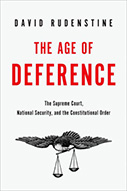The Age Of Deference: The Supreme Court, National Security, And The Constitutional Order

Author: David Rudenstine
Publisher: New York: Oxford University Press, 2016. 326p.
Reviewer: David Schultz | July 2017
The standard story of American constitutional law is one where, as Chief Justice Marshall declared in the 1803 Marbury v. Madison, it is the province of the Supreme Court to interpret the law and determine what is constitutional. This story asserts that the Constitution and the Bill of Rights are the supreme law of the law, that no institution including Congress or the presidency, may act in ways contrary to the provisions in these documents, and that the judiciary’s task is to police policy and defend individual rights against their encroachment by the other branches of government.
This standard model is criticized by law professors and court scholars who indicate that over time the federal courts have not always been the defender of individual rights of the oppressed such as those accused of crimes, people of color, or dissidents, but that for most of its history the rights defended were those of property, business, and mainstream Caucasian males. Rudenstine takes this critique or argument one step further, asserting that not only has the Supreme Court not consistently defended individual rights, but that when it comes to the issue of national security, the judiciary has actually participated in the erosion of basic civil liberties and rights, reinforcing rather than checking the actions of the other branches of government. It has enabled the national security state.
Rudenstine’s subject is national security and the Constitution. His thesis is that what he calls the “ingrained narrative” is flawed. The ingrained narrative is one where during times of war or threats to national security the courts are more likely to defer to Congress and the presidency than during times of peace. The Supreme Court was deferential to President Lincoln and Congress during the Civil War, Wilson and Congress during World War I, and Roosevelt and Congress during World War II. Yet once hostilities ended, the courts reassert themselves, enunciate precedents that outlaw previous constitutional abuses, and resume their role as defenders of individual rights. There is thus an interplay in judicial action and rights that transcends war and peace, asserting that rights eventually win and are strengthened by the Supreme Court. This narrative is hopeful but wrong according to Rudenstine.
Instead, the author has painted a picture since World War II and the Cold War as one where the Supreme and lower federal courts have led the way in eroding constitutional protections and order, paving the way for situations where criminal law has collapsed into national security practice and the latter has been given deferential review at best by the judiciary.
Two Supreme Court cases pave the path for this trend. The first that Rudenstine discusses is Youngstown Sheet and Tube Company v. Sawyer, a 1952 case involving President Truman’s nationalizing of the steel mills during the Korean in order to prevent a union strike that might adversely hamper the war effort. While the Court agreed that the president’s action was illegal, Justice Robert Jackson’s famous concurrence elaborated three scenarios regarding presidential power in foreign affairs and national security, especially in case where presidents acted outside the United States. In those cases, presidents may enjoy more authority and presumptive deference than would be warranted under the Constitution were the action to take place within the borders of the United States.
The second case, the 1953 case of United States v. Reynolds, announced a series of rules the courts must follow when adjudicating cases that involve information the executive branch deems too sensitive to be released or used in court. In Reynolds, the case involved a suit against the United States and the air force for damages arising out of the death of a person serving in the military. The family of the deceased requested certain documents to prove their case, the government responded by asserting that the documents were top secret or classified, and the court eventually dismissed the case because adjudication of the dispute would have required the judiciary to examine documents that the executive branch said were protected for national security reasons. For Rudenstine, Reynolds is the beginning the Supreme Court creating the state secrets doctrine, refusing to question the executive branch in issues touching on national security when adjudicating rights claims. The Court simply deferred without questioning the validity of such arguments.
Paired Youngstown and Reynolds paved the way for a much broader and more expansive judicial abdication of judicial responsibility over the next sixty years, regardless of whether the United States was at war or peace. But given the Cold War and then the almost immediate descent into the War on Terrorism after 9/11, one might wonder whether the United States has ever really been at what is traditionally thought of as peace, and therefore whether the courts have had a realistic opportunity to default to the practices of the ingrained narrative.
Part one of this book develops and criticizes the ingrained narrative through Youngstown and Reynolds, and sets the foundation for what Rudenstine sees as further degeneration of judicial scrutiny when it comes to national security issues. The state secrets doctrine set precedent for relaxed warrant requirements, under the Foreign Intelligence Surveillance Act and effectively the creation of a secret court under the act. Post 9/11 and the Patriot Act, the Court has narrowed the scope of injury allowed by journalists and others wishing to defend themselves or raise challenges, and it has overall simply made it hard to know about national security issues, let alone challenge the actions of the executive branch. In effect, the Supreme Court has enabled the creation of the national security state; a state where the executive branch is given nearly free rein to do what it wants.
The Age of Deference is a powerful and intelligent book. It paints a scary world where the checks and balance of the American constitutional order have collapsed. It is bad enough that national security issues receive little scrutiny, but the courts are willing to defer even to the question regarding what should be considered a national security issue. The author concludes with a plea to rethink what constitutes a state secret and for the Court to take a less deferential view of abuses of rights in the name of national security, but there is little reason to think that Donald Trump will appoint justices and judges who will take up this call.
David Schultz, Professor, Department of Political Science, Hamline University, St Paul, MN, 55104.


